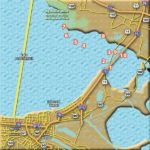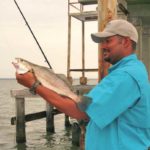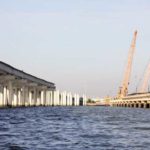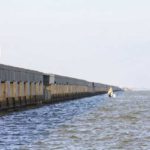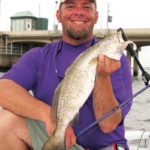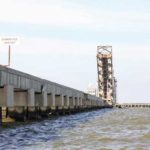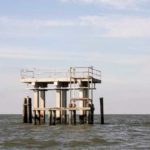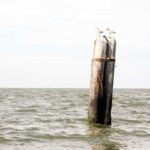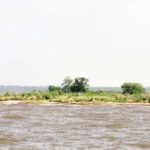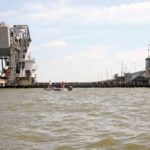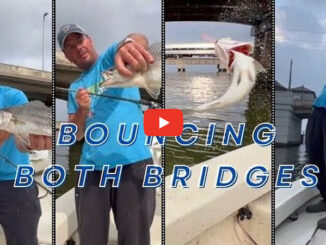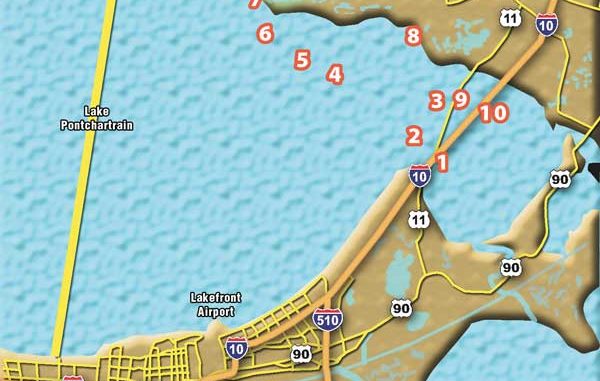
The big lake to the north of New Orleans is one of the few coastal places still open to fishing. Good thing it’s so productive this time of year.
I wonder if Iberville would have ever made it back to Ship Island had he carried sliding corks with him in his pirogue as he passed through the waters he named Maurapas and Pontchartrain.
Would he have gone on to secure the mouth of the Mississippi River and its surrounding lands for France?
Or would he have dropped anchor in Lake Pontchartrain and allowed the ebb and flow of the tide to carry his live shrimp into the mouths of the lake’s many speckled trout?
Think about it. Iberville could have had the entire lake to himself. It wouldn’t have mattered where he fished. Lake Pontchartrain would have been a virgin fishery.
Today, things are different. You’re not going to have Lake Pontchartrain to yourself no matter what time of year or day you go. It does matter where you fish. And although the lake’s trout are probably still just as bountiful, in no way could they be considered innocent.
“They’ve been there, seen that and bought the T-shirt,” Capt. Eric Dumas said.
As if its location in the middle of the most heavily populated corner of Louisiana isn’t bad enough, the numbers of anglers launching in Lake Pontchartrain since the end of April has grown exponentially as anglers from St. Bernard, Plaquemines, Jefferson and Terrebonne parishes look for new places to fish.
That means there isn’t a fishing lure these trout haven’t seen. In fact, Dumas said during a recent trip to the Trestle that the trout turned off the plastics earlier this year than he could ever remember.
Now they are getting bombarded with shrimp under sliding corks, shrimp on Carolina rigs and shrimp under popping corks.
Since most locals have already switched to live shrimp by the summer, and since most newcomers are fishing live shrimp just to try to keep up with the locals, where you fish this summer will determine your degree of success more so than what you fish.
“If you’re not familiar with fishing Pontchartrain,” Dumas said, “the first thing you’ll notice is just how big it is. You’re not going to fish it all in one day — you just can’t. Pick a section of the lake — northeast, northwest, whatever — and learn it.”
Dumas chose to help you get a head start this summer by pointing out 10 spots in the northeastern corner of Lake Pontchartrain that will definitely put you ahead of the learning curve.
• No. 1: Twin Span South
N30 09.444 x W89 51.051
As the destruction of the old Twin Span continues and the construction of the new Twin Span nears completion, Dumas says the area where both run into the south shore is a dynamic spot to fish during the summer.
“There’s a lot of stuff falling in the water while they’re tearing down the old Twin Span,” he said. “Then you’ve got the pilings of the new Twin Span, and it’s all right here close together. Add the current that washes around this point, and you’ve got yourself a good fishing hole.”
Twin Span South doesn’t discriminate when it comes to what kind of fish anglers can catch. Dumas says the area is great for trout, redfish, black drum and sheepshead. And the one thing none of these fish can pass up during the summer is live bait.
“Rig up some live shrimp on a Carolina rig, pick you a spot and anchor,” Dumas said. “As long as you’re casting around the pilings, you’ll be in the right spot. I like to work out about a mile from the south shoreline. Cast into the current, and walk your Carolina rig back to you.”
• No. 2: Marker 177
N30 09.692 x W89 52.187
The train trestle that crosses the lake just to the west of the Highway 11 Bridge is as uniform as it is long. That makes it a difficult structure to fish for newcomers. Since it all looks the same, it’s hard to pick a spot to fish. One spot looks as good as the next.
“Try starting at mile marker 177,” Dumas suggested. “From here, you can work north or south and be in some good water. What makes this spot particularly good is that the current moves first here than at any other spot on the trestle.”
Dumas explained that the tide continues to move around the south end of the trestle even after it stops on the north end. And when it switches, the tide moves on the south end before it moves on the north end. That means this starting point seems to always have some water movement.
“Tie to the bridge on the downcurrent side, and fish Carolina rigs or sliding corks about 50 to 60 yards out the back of your boat,” Dumas said. “If it’s falling, fish the east side. If it’s coming in, fish the west side. Shrimp and croakers work, but I like pogies if I can get some.”
• No. 3: 1,000-Foot Marker
N30 12.427 x W89 49.991
If you’ve got a small boat, and the open water of Lake Pontchartrain intimidates you a little bit, Dumas says this is the spot for you if you want to get in on the bridge action. The 1,000-foot marker is 1,000 feet from the drawbridge, and it’s only about a mile run from the ramp at Dockside Bait & Tackle in Slidell.
“You can either fish toward the drawbridge or back toward the north shore,” Dumas said. “Some spots might be better than others on any given day. Pick a spot and anchor or tie off. If the action isn’t fast enough to keep you busy, pick up and move around. You’ll get on them eventually.”
Like most other spots on the train trestle, Dumas recommended fishing live shrimp. However, he sticks with the Carolina rig in this area. The current doesn’t move as fast as it does on the south shore, so the sliding cork doesn’t move around enough.
“You may lose some tackle, but try the firebreaks around this spot,” Dumas said. “This used to be an old wooden bridge, and a lot of pilings and shells and other rubble is scattered in the areas where you can see the old, concrete firebreaks still standing. They look entirely different than the rest of the bridge, so they are easy to spot.”
• No. 4: Lacombe Rig 1
N30 12.189 x W89 55.865
About three or four miles to the west of the train trestle are two small structures locally known as the Lacombe rigs. They are usually a little crowded first thing in the morning during the summer because it’s just a short run from the Bayou Lacombe boat launch. But lots of boats make the trip west after trying the trestle.
“I catch some trout off the rig to the east during the summer,” Dumas said. “But you can catch different fish depending on where you fish. The trout and flounder get over the shell piles off the rig, and the reds, black drum and sheepshead like to get up by the pilings.”
The best way to fish this first rig is to anchor out away from the rig on the upcurrent or upwind side and cast back toward the rig. For some reason, tying to the rig and casting out doesn’t work nearly as well.
“Stick with your live bait on the bottom with a Carolina rig here,” Dumas suggested. “And even though it will be crowded in the morning, you can catch fish all day long as long as there is a decent tide moving. It’s definitely a tide game here.”
• No. 5: Lacombe Rig 2
N30 13.567 x W89 57.310
Although it’s very similar to the eastern Lacombe rig, rig 2 to the west fishes a little bit differently. According to Dumas, this rig is known for producing even bigger trout than the first rig, and it’s more of a sliding-cork rig.
“It also has a lot more structure toward the east of this rig, whereas the first rig has shell pads all the way around it,” Dumas said. “You can use a Carolina rig, but it seems like I do better on the sliding cork.”
There is no magic depth to set your sliding cork because it varies every day. There are a few shelves around this rig, and there are a few hills. The best technique one day may be suspending your live shrimp just over the shells at 7 feet under a sliding cork, and the next day it could be setting it at 9 feet so your shrimp just barely drags over the shells.
“On this one, I would say to anchor farther out, and you don’t have to throw as close to the rig,” Dumas said. “Let the current take your Carolina rig out the back of your boat, and just pick up your weight and set it down. Fish all the way around your boat because they can be all over the east side of this rig.”
• No. 6: Single Piling
N30 14.072 x W89 59.427
If you’re in the area of the Lacombe rigs or Goose Point, Dumas says to spend a little time searching for a single group of three pilings that are bound by thick cable near the top. Although it doesn’t look like much, this spot will hold some really good speckled trout.
“It’s not the piling so much as it is the giant shell bed that surrounds it,” said Dumas. “You won’t catch much but trout, and they’re either here are they’re not. You’ll know soon enough either way because if they’re on the piling and eating they’ll bite pretty quick.”
The shell pile extends away from the piling approximately 50 yards all the way around, and the best way to fish the area is to anchor off and fan cast with Carolina-rigged live bait. Dumas prefers live fish here rather than shrimp.
“Throw some croakers, or try to catch some pogies in the bayous like Bayou Lacombe, Bayou Liberty or the bayou coming out of Mandeville Harbor,” he recommended. “I like the pogies, and I hook them through the eyes because they’re not going to be down there very long.”
• No. 7: Goose Point
N30 15.825 x W89 59.317
While most anglers fish Lake Pontchartrain in search of speckled trout, the area also produces some excellent redfish action, and nowhere in the lake is the action hotter than it is at Goose Point during the summer.
“Goose Point has a lot of grass growing around it, and it clears up like a swimming pool,” Dumas said. “If you like sight fishing for pushing redfish, this is one of the few spots on Pontchartrain where you can do it.”
Dumas said to let the wind push you through the grass beds rather than trying to troll through them. As you see redfish, cast toward them with gold spoons or soft plastics rigged on jigheads. Anglers can also blind cast spoons along the edges of the grass.
“You can also pick up some school trout here if you back off and fish the edges of the grass,” Dumas said. “You may catch some early in the morning on topwater, but most of them will come on shrimp fished under a popping cork.”
• No. 8: Mouth of Salt Bayou
N30 14.863 x W89 52.134
The mouth of Salt Bayou is an interesting place because there are so many ways to catch so many different kinds of fish. Speckled trout, white trout, croakers, redfish, sheepshead and even bass can all be found around this spot, and that makes it a great place to salvage a difficult day on the water.
“White trout and croakers get right in the middle of the bayou,” said Dumas. “Fish them with market bait on the bottom. If the wind is blowing, head up the bayou and toss some worms around the grass for the bass. All three of those will tug on your line when nothing else seems to be biting.”
For the speckled trout, Dumas says to get about halfway between the group of pilings and the shoreline. There should be some grass growing off the shore, but it will stop where the bottom drops down to about 4 feet. Fish that break with live shrimp or pogies under a popping cork.
“Hit the pilings if you want to catch redfish or sheepshead,” Dumas said. “Throw some market bait under a cork or on bottom while you just troll around the pilings. If you don’t have a trolling motor, just tie off and fish as much as you can before moving.”
• No. 9: Draw Bridge Shell Pad
N30 12.154 x W 89 50.171
Just south of the Highway 11 drawbridge is a subtle shell pad that rises up only about a foot off the bottom. Dumas says the surrounding area is 14 feet deep, and the top of the shell pad is 13 feet deep. The presence of lights around the drawbridge makes this a 24-hour-a-day spot.
“Night fishing is really good right here because of the light,” said Dumas. “But you can fish all day long because there’s always some good water movement through here. The shell pad isn’t very large, so just fish around until you feel them. The coordinates for this spot will put you right on top of the pad.”
Carolina rigs and slip corks work well here, but Dumas likes to use a drop-shot rig that puts his weight on the bottom with his bait suspended above it. This allows him to fish the shells without getting hung as much.
“You can also get right up on the wooden structure around the drawbridge and catch trout and sheepshead,” Dumas added. “Find where the water is breaking around something and fish behind the swirl. Anywhere you’ve got some current will be good.”
• No. 10: Twin Span Drum Hole
N 30 11.915 W 89 48.428
When all else fails, Dumas says to head to the new Twin Span and fish the big concrete blocks that support the pilings under the hump. This is a great kids’ spot because there are just tons of drum that circle the blocks looking for something to eat.
“If you’ve got some kids with you and you want to hear them scream, fish these blocks with Carolina-rigged market bait,” Dumas suggested. “Give them a couple minutes to get going, but hold on when they do because you can load up.”
Dumas says most of the fish are 17- to 19-inch black drum, but he sometimes catches drum up to 34 inches. There are also some redfish that get in with the drum, but this isn’t a species-specific spot as much as it is an action spot.
“Anchor off the corners so you can fish two sides at a time,” Dumas said. “You won’t break off a lot because it’s open, but the big drum will run you into the pilings. Most of them are within 5 to 10 feet from the concrete.”
Contact Capt. Eric Dumas at 985-705-1244.
